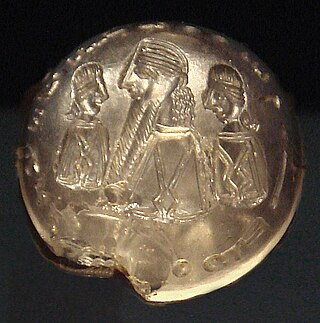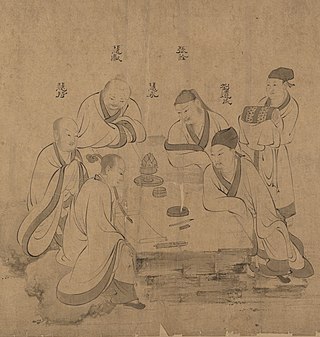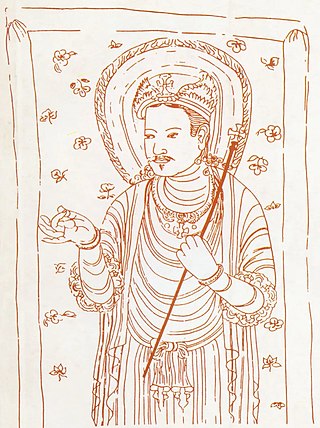
Manichaeism is a former major world religion, founded in the 3rd century CE by the Parthian prophet Mani, in the Sasanian Empire.

Chinese Buddhism or Han Buddhism is a Chinese form of Mahayana Buddhism which draws on the Chinese Buddhist canon that includes the indigenous cultural traditions of Confucianism and Taoism and the rituals of local colloquialised folk religions. Chinese Buddhism focuses on studying Mahayana sutras and Mahāyāna treatises and draws its main doctrines from these sources. Some of the most important scriptures in Chinese Buddhism include: Lotus Sutra, Flower Ornament Sutra, Vimalakirtī Sutra, Nirvana Sutra, and Amitābha Sutra. Chinese Buddhism is the largest institutionalized religion in mainland China. Currently, there are an estimated 185 to 250 million Chinese Buddhists in the People's Republic of China. It is also a major religion in Taiwan, Singapore, and Malaysia, as well as among the Chinese Diaspora.

Mani was a Parthian prophet and the founder of Manichaeism, a religion most prevalent in late antiquity.

The Arzhang, also known as the Book of Pictures, was one of the holy books of Manichaeism. It was written and illustrated by its prophet, Mani, in Syriac, with later reproductions written in Sogdian. It was unique as a sacred text in that it contained numerous pictures designed to portray Manichaean cosmogony, which were regarded as integral to the text.

The term White Lotus Society or White Lotus Teaching refers to a variety of religious and political groups that emerged in China over many centuries. Initially, the name was associated with Pure Land Buddhist organizations that sought to promote devotional practices centered rebirth in a Buddha's Pure Land. These early societies emphasized spiritual salvation through faith, chanting of Amitābha's name (nianfo), and adherence to moral precepts.
The Manichaean Psalm Book or Manichaean Psalter is a Manichaean text written in Coptic. It is believed to have been compiled in the late 3rd century or the mid-4th century. Excavated in 1929 as part of the Medinet Madi library, the Psalm Book is believed to contain remnants of some of the earliest extant Manichaean literature.
The Shabuhragan, which means "dedicated to Šābuhr", also translated in Chinese as the Chinese: 二宗经; pinyin: Èrzōng jīng; lit. 'Text of Two principles' was a sacred book of Manichaeism, written by the founder Mani himself, originally in Middle Persian, and dedicated to Shapur I, the contemporary king of the Sasanian Empire. This book is listed as one of the seven treatises of Manichaeism in Arabic historical sources, but it is not among the seven treatises in the Manichaean account itself. The book was designed to present to Shapur an outline of Mani's new religion, which united elements from Zoroastrianism, Christianity, and Buddhism.
Buddhologist Edward Conze (1966) has proposed that similarities existed between Buddhism and Gnosticism, a term deriving from the name Gnostics, which was given to a number of Christian sects. To the extent that Buddha taught the existence of evil inclinations that remain unconquered, or that require special spiritual knowledge to conquer, Buddhism has also qualified as Gnostic.

Mar Ammo was a 3rd-century Manichean disciple of the prophet Mani. According to Manichaen tradition he spread Manichaeism eastward into Sogdiana during the time period when Mani was living. Mar Ammo is well known as the apostle of the east in Manichean literature nevertheless his exact origins are unknown. His Syriac name may denote that he was Syrian in origin. However, a Parthian origin may also be seen and is mentioned by some scholars, especially due to his outstanding role in establishing the Parthian language as the official language of the eastern Manichean Church, later to be replaced by Sogdian in the sixth century. Furthermore, Mar Ammo is widely regarded as the composer of the Manichaean Parthian hymn-cycles.

Cao'an is a temple in Jinjiang, Fujian, Luoshan Subdistrict. Originally constructed by Chinese Manichaeans, it was considered by later worshipers to be a Buddhist temple. This "Manichaean temple in Buddhist disguise" had historically been seen by modern experts on Manichaeism as "the only Manichaean building which has survived intact". However, other Manichaean buildings have survived intact, such as the Xuanzhen Temple, also in China. In 2021, Cao'an was inscribed on the UNESCO World Heritage List along with many other sites near Quanzhou because of its unique testimony to the exchange of religious ideas and cultures in medieval China. Over 2022, the number of tourists to the location doubled and preservation efforts began.
The Maitreya teachings or Maitreyanism, also called Mile teachings, refers to the beliefs related to Maitreya practiced in China together with Buddhism and Manichaeism, and were developed in different ways both in the Chinese Buddhist schools and in the sect salvationist traditions of Chinese folk religion.

Chinese Manichaeism, also known as Monijiao (Chinese: 摩尼教; pinyin: Móníjiào; Wade–Giles: Mo2-ni2 Chiao4; lit. 'religion of Moni') or Mingjiao (Chinese: 明教; pinyin: Míngjiào; Wade–Giles: Ming2-Chiao4; lit. 'religion of light or 'bright religion'), is the form of Manichaeism transmitted to and currently practiced in China. Chinese Manichaeism rose to prominence during the Tang dynasty and despite frequent persecutions, it has continued long after the other forms of Manichaeism were eradicated in the West. The most complete set of surviving Manichaean writings were written in Chinese sometime before the 9th century and were found in the Mogao Caves among the Dunhuang manuscripts.

The Manichaean Painting of the Buddha Jesus (Chinese: 夷數佛幀; pinyin: Yí shù fó zhēn; Wade–Giles: I2-shu4 fo2-chên1; Japanese: キリスト聖像; rōmaji: Kirisuto Sei-zō; lit. 'Sacred Image of Christ'), is a Chinese Southern Song dynasty silk hanging scroll preserved at the Seiunji Temple in Kōshū, Yamanashi, Japan. It measures 153.5 cm in height, 58.7 cm in width, dates from the 12th to 13th centuries, and depicts a solitary nimbate figure on a dark-brown medieval Chinese silk. According to the Hungarian historian Zsuzsanna Gulácsi, this painting is one of the six documented Chinese Manichaean hanging scrolls from Zhejiang province from the early 12th century, which titled Yishu fo zhen (lit. "Silk Painting of the Buddha [Prophet] Jesus").

Manichaean scripture includes nine main books: the Seven Treatises of Manichaeism, all personally written by Mani in Syriac, the Shabuhragan written by Mani in Middle Persian, and the Arzhang, a series of illustrations painted by Mani.

In Manichaeism, Jesus is considered one of the four prophets of the faith, along with Zoroaster, Gautama Buddha and Mani. He is also a "guiding deity" who greets the light bodies of the righteous after their deliverance.

Manichaean Temple Banner Number "MIK Ⅲ 6286" is a Manichaean monastery flag banner collected in Berlin Asian Art Museum, made in the 10th century AD. It was found in Xinjiang Gaochang by a German Turpan expedition team at the beginning of the 20th century. The flag streamer is 45.5 cm long and 16 cm wide, with painted portraits on both sides. It is a funeral streamer dedicated to the deceased Manichae believers.

The three Persian religions, as a medieval Chinese concept, referred to a group of Iranian religions that spread to Tang China. They were recognized and protected under Tang rule, helping them to prosper in China at a time when Sassanid Iran was falling to the early Muslim conquests. The three religious movements identified by the term were Zoroastrianism, the Church of the East, and Manichaeism.
Master Ulug was a Uyghur Manichaean missionary in the Tang Dynasty

Manichaeism has a rich tradition of visual art, starting with Mani himself writing the Book of Pictures.

In Manichaeism, Zarathustra is considered one of the four prophets of the faith, along with Buddha, Jesus and Mani. Mani believed that the teachings of Gautama Buddha, Zarathustra, and Jesus were incomplete, and that his revelations were for the entire world, calling his teachings the "Religion of Light".















